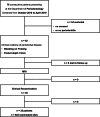MRI-detected intraosseous bone marrow edema recedes after effective therapy of periodontitis
- PMID: 37855855
- PMCID: PMC11126442
- DOI: 10.1007/s00330-023-10327-6
MRI-detected intraosseous bone marrow edema recedes after effective therapy of periodontitis
Abstract
Objectives: T2 STIR MRI sequences can detect preclinical changes associated with periodontal inflammation, i.e. intraosseous edema in the tooth-supporting bone. In this study, we assessed whether MRI can be used for monitoring periodontal disease.
Material and methods: In a prospective cohort study, we examined 35 patients with periodontitis between 10/2018 and 04/2019 by using 3D isotropic T2-weighted short tau inversion recovery (STIR) and Fast Field Echo T1-weighted Black bone sequences. All patients received standardized clinical exams before and three months after non-surgical periodontal therapy. Bone marrow edema extent was quantified in the STIR sequence at 922 sites before and after treatment. Results were compared with standard clinical findings. Non-parametric statistical analysis was performed.
Results: Non-surgical periodontal treatment caused significant improvement in mean probing depth (p < 0.001) and frequency of bleeding on probing (p < 0.001). The mean depth of osseous edema per site was reduced from a median [IQR] of 2 [1, 3] mm at baseline to 1 [0, 3] mm, (p < 0.001). Periodontal treatment reduced the frequency of sites with edema from 35 to 24% (p < 0.01).
Conclusion: The decrease of periodontal bone marrow edema, as observed with T2 STIR MR imaging, is indicative of successful periodontal healing.
Clinical relevance statement: T2 STIR hyperintense bone marrow edema in the periodontal bone decreases after treatment and can therefore be used to evaluate treatment success. Furthermore, MRI reveals new options to depict hidden aspects of periodontitis.
Key points: • T2 STIR hyperintense periodontal intraosseous edema was prospectively investigated in 35 patients with periodontitis before and after treatment and compared to clinical outcomes. • The frequency of affected sites was reduced from 35 to 24% (p < 0.001), and mean edema depth was reduced from a median [IQR] of 2 [1, 3] mm at baseline to 1 [0, 3] mm 3 months after treatment. (p < 0.001). • T2 STIR sequences can be used to monitor the posttreatment course of periodontitis.
Keywords: Magnetic resonance imaging; Periodontal disease; Periodontitis.
© 2023. The Author(s).
Conflict of interest statement
MP and FAP have applied for a German patent for a device and method to support the imaging of MRI.
The other authors of this manuscript declare no relationships with any companies, whose products or services may be related to the subject matter of the article.
Figures



Comment in
-
Periodontitis: a new territory for MRI.Eur Radiol. 2024 May;34(5):3113-3114. doi: 10.1007/s00330-023-10466-w. Epub 2023 Dec 8. Eur Radiol. 2024. PMID: 38063865 No abstract available.
References
MeSH terms
LinkOut - more resources
Full Text Sources
Medical

